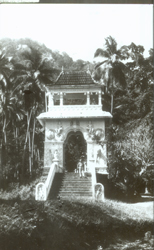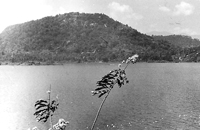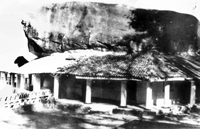
|
Intriguing rock cave temple of the Dumbara Valley The Dumbara Valley in the distant past was the seat of ancient temples, Raja Maha Viharas and rock cave hermitages (Aranne) where Buddha statues were housed. Dr. John Davy, surgeon to British Governor Sir Robert Brownrigg in his palanquin tours in 1817 had stumbled on some of these cave hermitages close to Teldeniya, a few miles from Kandy.
In his voluminous book “An Account of Ceylon”, Davy gives a graphic description of the rock shelters he had come across, among them Bambaragala Aranna. “....in the evening before sunset, we walked about half a mile to the Bambaragala Vihara, romantically situated on the side of a steep hill, amongst masses of rock……The cavity of the rock, very prettily and gaily painted was divided into two compartments in the largest of which there was a recumbent figure of a Buddha statue about five feet long.”
The old roadway to the temple via Henagahuwela was submerged by the waters of the Victoria reservoir and now access to the temple is through Tennekumbura, on the main Mahiyangane road leading to the Victoria dam site. A steep flight of stone steps leads to the summit of this rock cave temple, where halfway up is the priests’ residency (Avasa). At the top is an assembly of ancient rock cave hermitages (lenas), with prominent drip ledges carved for the rain to drip down. The Brahmi inscriptions etched on the apex of the cave have been deciphered and reveal that these rock caves were donated to the Sangha by the ruling monarchs dating back some 2000 years. Former Archaeological Commissioner Dr. Senerath Paranavitane in his Inscriptions of Ceylon, Vol 1 (1970), writes of the Bambaragala rock inscriptions. These inscriptions date back to the 2nd and 3rd Century BC.
During the reign of King Kirthi Sri Rajasingha, (1747-1782 AD) of the Kandyan period, a vihara was built, the ruins of which are still to be seen. A Thamba Sannasa ( royal edicts written on copper plates) says that the surrounding lands had been gifted by the king of the time to the Bambaragala Rock Temple. The mural paintings adorning the walls of the temple depict fascinating episodes of Jataka stories, combined with cultural and Buddhistic motifs. Their value lies not only in their beauty but also in their worth as a historical record. The floral patterns on the motifs are of tendrils and leaves. The lotus in full bloom is drawn on the ceiling. Prof. Sri Gunasinghe, an authority on Kandyan paintings says in his monograph, ‘Buddhist paintings of the Kandyan period’, “ A favourite subject of the Kandyan artists without doubt is the Jataka Story- past lives of the Buddha which also supply the major theme for this particular group of murals. Human figures often seen in mixed and frontal view of different parts of the body (profile) being more favoured, however are delineated with little appreciation of anatomical truth or natural proportions. Despite their being engaged in various activities, the figures remain static in effect”. |
| || Front
Page | News
| Editorial
| Columns
| Sports
| Plus
| Financial
Times | International | Mirror
| TV
Times | Funday
Times | Kandy
Times || |
| |
Copyright
2007 Wijeya
Newspapers Ltd.Colombo. Sri Lanka. |


